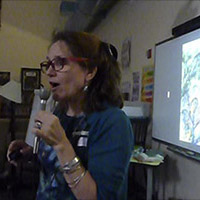Citizen Science Turtle Time: Human Impact on their Ecosystem (3 - 5)
Last changed: 08/16/2021 3:17pm| 3 , 4 , 5 | |
| Theater | Science English |
| Grade Level Program | Access |
| 1 | 60 min |
| In-School Performance | In-school interactive performance intended for individual classes to experience separately. |
| All year | In-School, |
| $10 | 0 |
| yes | Phone , Email |
|
Artist brings powerpoint slides on a thumbdrive to plug into the classroom system. Artist projector and laptop if not available in the classroom. Artist will bring paper copies (picture book format) of slides as back up;
study guide; resource materials; props as needed for further discussion and demonstration |
|
|
Screen or blank wall for slide show; darkened room; pencils; clipboards (if available) and paper; white board or chart paper
Artist will bring the slide show in book format which can be used for individual classrooms if technology isn't available |
|
|
Classroom set up, students seated facing the smart board or screen seated at desks or on the rug in audience formation.
|
|
|
I can define a nocturnal animal.
I can describe how artificial light at night confuses nocturnal animals. I can describe how the performer used repetition to emphasize a point. I can use story and art to tell a story that matters to me. |
|
|
Citizen Science: Turtle Time and Human Impact on their Ecosystem is a non-fiction, illustrated, and interactive spoken word performance performance that describes how sea turtle behavior depends on the environmental cues of day and night. When turtles confuse artificial light for moonlight on the water, they might go the wrong direction and need human help to find their way. The story ends on the upbeat message that as we modify our lighting technologies to protect the environment, turtle hatchlings will once again "find their way to their ocean home" .
Students participate by joining in on repetitive phrases and hand-gestures during the performance and if in the classroom, a drawing activity and citizen science Q & A. Discussion and Q & A focus on how and why the performer uses artistic techniques such repetition. Q & A also highlight how an artist uses their art form to advocate for a social and environmental concern. Students are invited to become Citizen Scientists by reflecting on what they can observe and record in their own environments, whether insects at lights, nocturnal animals, or how lighting technologies are used. Grade Level Adaptations include: modifying vocabulary up and down for grade level; using additional visual aids as needed; and adapt the discussion to grade level science and performance standards. Performance adaptations include stopping mid-stream for upper grades to brainstorm solutions before they are presented, or writing out the repetitions on a white board for younger learners. |
|
|
Use your art form to make a difference! This program demonstrates how an artist wrote, illustrated, and performs a non-fiction story to address real-life social and environmental concerns. The format of this work can be used as a model for student non-fiction research and writing.
|
|
|
Volunteers can assist students with repetition at appropriate moments in the performance; volunteers can assist with Q &A as well as pass out paper and pencil when appropriate.
|
|
Grade 3 |
|||
|
|||
Grade 4 |
|||
|
|||
Grade 5 |
|||
|

